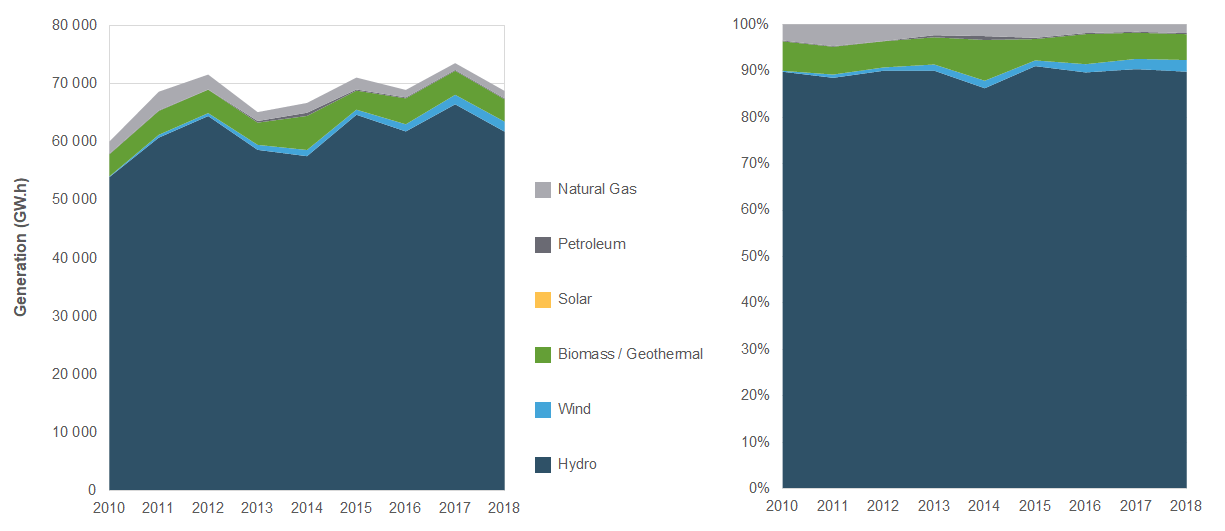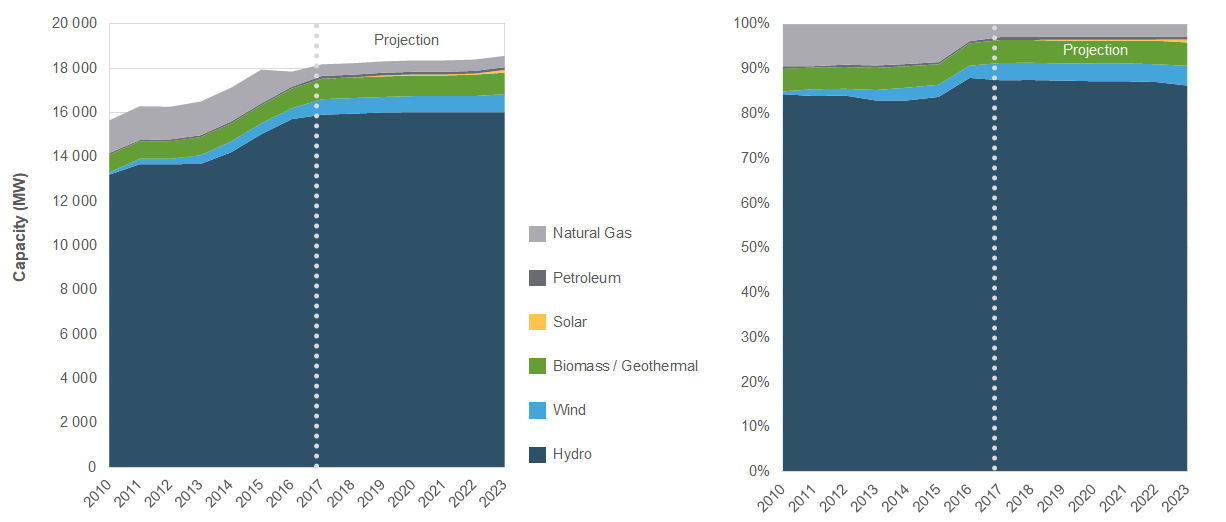Canada's Renewable Power – British Columbia

British Columbia

British Columbia (B.C.) is one of the largest producers of renewable energy in Canada. Since 2010, B.C.’s hydro capacity has grown by 2 703 megawatts, the most of any province in Canada. B.C. is also the largest generator of electricity from biomass in Canada.
Generation Trends
B.C.’s natural geography and public policies have contributed to making hydro the province’s largest source of electricity. In 2018, hydro generated 89.8% of B.C.’s electricity. Biomass was the second largest source of electricity, mainly consuming wood waste from the forestry and pulp and paper industries. Biomass generated 3 837 gigawatt-hours (GW.h), or 5.6% of generation, in 2018. This is the highest biomass share of any province or territory. Total renewable generation in 2018 was 67 352 GW.h, or 97.9% of total generation.
Non-renewable thermal generation in B.C. is mostly natural gas-fired. Diesel-fired generation is used in remote communities not connected to the provincial electricity grid or a natural gas distribution line. Total thermal generation in 2018 was 1 450 GW.h, or 2.1% of total generation.
Total electricity generation in B.C. grew from 60 101 GW.h in 2010 to 68 802 GW.h in 2018. Changes in B.C.’s electricity generation mix are shown in Figure 1.
Figure 1. Electricity Generation in British Columbia

Source and Description
Source: CER – Canada’s Energy Future 2020 (EF2020)
Description: This graph illustrates electricity generation from 2010 to 2018 in B.C. In 2010, B.C.’s total generation was 60 101 GW.h (96.3% renewable). In 2018, total generation was 68 802 GW.h (97.9% renewable).
Emissions from Electricity Generation
In 2018, B.C.’s electricity sector emitted 0.7 megatonnes of carbon dioxide equivalent (MT of CO2e). B.C.’s generation intensity was 12.3 grams CO2e per kilowatt-hour.
B.C. produced 1% of Canada’s total greenhouse gas (GHG) emissions from electricity generation in 2018.
Biomass Generation
In 2017, close to 2 500 MW of biomass capacity was installed in Canada and 9 236 GW.h of electricity was generated. The provinces with the largest biomass-fired capacity are those with significant forestry operations. B.C. is the largest generator of biomass-fueled electricity in Canada.
Biomass generation is a form of thermal generation, but is categorized as renewable in this report. Industrial wood waste, especially waste from the pulp and paper industry, is used to produce electricity and steam. Biomass can also include spent pulping liquor, landfill gas, and organic municipal solid waste.
Biomass is considered non/low-emitting because the carbon released from burning biofuels was previously absorbed out of the atmosphere by plants and could be reabsorbed by new plants. The net CO2 emissions from using biomass fuel can be close to zero, if biomass is used at the same rate that it regenerates.
The combustion of biomass also emits GHGs other than CO2, including methane and nitrogen dioxide.
Recent and Projected Capacity Changes for Renewables
Between 2010 and 2017, B.C. added a net 3 444 megawatts (MW) of renewable capacity, primarily in the form of hydro (2 703 MW). Between 2017 and 2023, B.C. is projected to add 387 MW of new net renewable capacity. These capacity changes are illustrated in Figure 2 with data provided in Table 1.
Figure 2. Electricity Capacity and Future Changes in B.C.

Source and Description
Source: CER – EF2020
Description: This graph illustrates historical electricity capacity from 2010 to 2017 in B.C. and the CER’s projection of future capacity changes from 2018 to 2023. In 2010, B.C.’s total installed electricity capacity was 15 651 MW (90.1% renewable). In 2017, capacity had grown to 18 182 MW (96.5% renewable). By 2023, total capacity is projected to grow to 18 561 MW (96.6% renewable).
Recent and future projects included in the projection are:
- Meikle Wind Energy Project, which added 184 MW in 2017.
- Okanagan Wind, which added 30 MW in 2017 and is expected to expand to 120 MW by 2023.
- Boulder Creek, a peak hydro project that added 25 MW in 2017.
- Big Silver Creek, a peak hydro project that added 40.6 MW in 2017.
- Upper Lillooet River, a peak hydro project that added 81 MW in 2017.
- Several biomass projects, including Merritt Green Energy and Fort St. James Green Energy, that added 120 MW in 2017, and are expected to expand to 240 MW by 2023.
- Provincial government mandates and targets of new peak hydro and new solar to add up to 300 MW and 8 MW of new capacity, respectively, by 2023.
Not included in Figure 2 or Table 1 is BC Hydro’s Site C project. Site C is expected to begin reservoir filling and operation in 2024/25. When completed, the project will add 1 100 MW of new hydro capacity.
Table 1. Electricity Capacity (2010 – 2023) and Generation (2010 and 2018) in B.C.
| Capacity in MW and % | Generation in GW.h and % | ||||||
|---|---|---|---|---|---|---|---|
| 2010 | 2017 | 2018 | 2020 | 2023 | 2010 | 2018 | |
| ---------- Projected ---------- | |||||||
| Hydroelectricity | 13 202 | 15 905 | 15 955 | 16 017 | 16 017 | 53 971 | 61 791 |
| 84.3% | 87.5% | 87.5% | 87.3% | 86.3% | 89.8% | 89.8% | |
| Wind | 102 | 702 | 702 | 732 | 817 | 123 | 1 724 |
| 0.7% | 3.9% | 3.9% | 4.0% | 4.4% | 0.2% | 2.5% | |
| Biomass / Geothermal | 791 | 928 | 928 | 928 | 968 | 3 811 | 3 837 |
| 5.1% | 5.1% | 5.1% | 5.1% | 5.2% | 6.3% | 5.6% | |
| Solar | 0 | 3 | 3 | 43 | 123 | 0 | 0 |
| 0.0% | 0.0% | 0.0% | 0.2% | 0.7% | 0.0% | 0.0% | |
| All Renewable Sources | 14 095 | 17 539 | 17 589 | 17 721 | 17 926 | 57 905 | 67 352 |
| 90.1% | 96.5% | 96.5% | 96.5% | 96.6% | 96.3% | 97.9% | |
| Natural Gas | 1 475 | 520 | 520 | 513 | 513 | 2 089 | 1 291 |
| 9.4% | 2.9% | 2.9% | 2.8% | 2.8% | 3.5% | 1.9% | |
| Oil and Diesel | 82 | 122 | 122 | 122 | 122 | 107 | 159 |
| 0.5% | 0.7% | 0.7% | 0.7% | 0.7% | 0.2% | 0.2% | |
| All Thermal Sources | 1 557 | 643 | 643 | 635 | 635 | 2 196 | 1 450 |
| 9.9% | 3.5% | 3.5% | 3.5% | 3.4% | 3.7% | 2.1% | |
| All Sources | 15 651 | 18 182 | 18 232 | 18 356 | 18 561 | 60 101 | 68 802 |
- Date modified:
